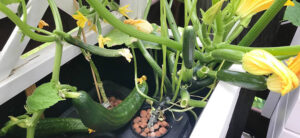
Do you love zucchini but don't have room to plant it in your garden? Are you looking for a creative way to grow food indoors during the winter months? You should try growing zucchini hydroponically.
You may be asking, how does zucchini grow? Growing zucchini is easy and can be done right from your own kitchen. If you’re not yet familiar with it, hydroponics is a method of growing plants without soil, instead using nutrient-rich water.
The process allows gardeners to grow all year round with little maintenance. It also reduces the number of chemicals needed because it provides nutrients directly to the plant through its roots.
Ready to dive into growing hydroponic zucchini but not sure where to start? We’ll tell you everything you need to know about growing zucchini hydroponically.
Can You Grow Zucchini Hydroponically?
Can you grow zucchini in a hydroponic setup? Absolutely. Growing zucchini hydroponically is a great way to save space in your garden by moving things inside.
Anyone can grow their own zucchini hydroponically. There are some benefits for those that have more experience with gardening. You will need to recognize the challenges that traditional gardening can present. Hydroponics can help reduce or eliminate some of these challenges.
If you've grown zucchini outdoors, you'll be delighted to learn that common pests and diseases are less likely. Pests like squash bugs or cucumber beetles won't be as much of a problem indoors.
Is Hydroponic Zucchini Difficult To Grow?
It is not difficult to grow zucchini in a hydroponic system. You’ll find that you can produce a large harvest in a short period of time.
You can harvest zucchini year-round. This allows for a garden that provides you with an endless harvest of these tasty fruits.
As long as you have the right equipment and expertise, you shouldn’t experience any difficulty in growing zucchini hydroponically.
Why Consider Growing Zucchini Hydroponically?
There are countless benefits to hydroponic growing. All of these benefits can be applied to zucchini as well.
Not only does growing in a hydroponic system allow you total control, but it also makes it possible for you to produce lots of fruits in a limited amount of space.
It’s the ideal method of growing for gardeners living in crowded environments. It uses fewer resources than if you were growing outside and can often lead to greater yields.
Some people question whether produce from hydroponics is as nutritious as that which is grown in a traditional setting. Recent studies suggest that hydroponic plants offer larger and better-tasting fruits due to a higher nutrient concentration and cleaner method of growing. The fruits are typically just as nutritious if not more.
Plus, when you grow zucchini hydroponically, you don’t have to worry about pests and diseases.
You will have virtually none of the issues with pests like squash bugs or diseases like wilt that you might have in an outdoor setting. It’s low-maintenance zucchini gardening at its finest!
How Long Does Growing Zucchini Take?
Zucchini seeds generally germinate in around 7-14 days and you should have plants that are ready to be harvested in about two months.
After those first two months, as long as you harvest zucchini often, you will be able to harvest pretty much nonstop.
How To Grow Hydroponic Zucchini
Are you ready to start growing zucchini in your hydroponic system? You’ll need to start by gathering your equipment. Deciding on the best system for growing your plants is the ideal place to start. After that, it’s on to planting, caring for, and finally harvesting, your delicious fruits.
You’ll have quite a bit of choice in how to grow your hydroponic plants, particularly when it comes to choosing the type of system you’d like to use.
What Type Of System Is Best For Growing Zucchini Hydroponically?
There are two primary hydroponic systems that growers use when growing zucchini - aquaponics and ebb and flow.
Aquaponics is the best way to grow your own vegetables while also raising fish. Fish produce ammonia and nitrates which are used as fertilizer for plants. They also provide nutrients like phosphorus, magnesium, and potassium.
The plants filter out toxins from the water. This makes them vital in maintaining healthy conditions for both animals and plants. This kind of system works great with zucchini because it tends to be a heavy feeder.
Another option is ebb and flow. It is ideal for beginner gardeners. It is often referred to as flood and drain and is an easy system to operate.
A grow tray or flood table will hold your plants in place with a reservoir filled with water and nutrients underneath.
The system will flood the roots of your plants with nutrients and water, then slowly drain the two back out.
Ebb and flow is a good choice for zucchini because it doesn’t leave the roots of the plants constantly immersed in nutrients and water.
Zucchini can easily rot, so this kind of system is ideal to keep things moist, but not too wet.
Hydroponic Zucchini Propagation - Seeds vs Clones
Growing zucchini from seed is the ideal method of starting these plants. You can sow your seeds in warm vermiculite or moistened coco-peat starter plugs.
Sow the seeds about ¾” inch deep and keep them well-watered and warm (ideally at a temperature of around 70 degrees).
This helps stabilize the roots of the plants while also ensuring that the seed-starting mixture retains moisture.
Your seeds should germinate in two weeks or less. Once your seedlings push through the media, you can transplant them into your hydroponic system. Keep them even warmer and well-watered here. 80 to 90 degrees is the ideal temperature.
When you place your zucchini plants in the hydroponic system, be careful. It can be easy to crush the roots, as they’re quite fragile.
You can grow any kind of zucchini in your hydroponic system. As a summer squash, some of the best varieties of zucchini to consider growing include ‘Black Beauty,’ ‘Raven,’ and ‘Bush Baby.’
Bush varieties, as well as those that are suited for growing in containers, tend to be the best options for hydroponic growers. This is because they are meant to grow in a more compact fashion.
Feeding Your Hydroponic Zucchini Nutrients
When fertilizing your zucchini plants, use a preformulated nutrient mixture that is specifically for hydroponics.
This will offer your plants exactly what they need. Keep the pH around 6.0 and use a fertilizer that is around 8-16-36 for the best results.
You will need to change out your nutrient solution once or twice per month. This depends on what kind of system you are using and how many plants you decide to grow.
Caring For Your Hydroponically Grown Zucchini
Zucchini is unique because you do not need to lower the growing temperature at night.
Zucchini plants need a lot of sunlight so you will need to provide them with around 14 hours of light per day with your grow lights.
This will allow larger, more ample fruits to develop. When you grow hydroponic zucchini, as when growing any kind of zucchini, you will need to set up a zucchini trellis.
This will stop the plants from wandering every which way. Growing a variety of zucchini can often eliminate this need. You should still plan on setting up a zucchini trellis to secure plants in the system and to make sure that all parts receive adequate light.
Pollination will be necessary for your plants. You can dab the center of flowers with a paintbrush, transferring pollen from the male flowers to the female ones. Female flowers have an immature swollen area while male flowers have a thin, narrow stalk.
How To Harvest Your Hydroponically Grown Zucchini
You can harvest zucchini when your plants are around six to eight inches long. Be careful about leaving fruits on the plants for too long. This can cause the seeds to become oversized and the fruits to become bitter.
Pick fruits often as this will give you a larger harvest. Ripe fruits will be firm and dark green, while those that are squishy and soft have likely begun to rot. Throw these away to avoid attracting pests.
Final Thoughts On Growing Zucchini Hydroponically
Growing zucchini hydroponically can be a difficult process for the beginner gardener. It takes a lot of time and effort to make sure that plants are getting enough food, water, and light to grow strong and healthy.
However, with the right balance of nutrients and the right system, you’ll have an amazing harvest of hydroponic zucchini without much work at all!
You’ll find everything you need to get started with growing hydroponic zucchini by shopping at Hydrobuilder.
Our extensive hydroponics selection carries everything you need for a dream hydroponics system. From growing media to seed starting equipment, all at affordable prices and with the best customer service around. Shop today to see for yourself!



































